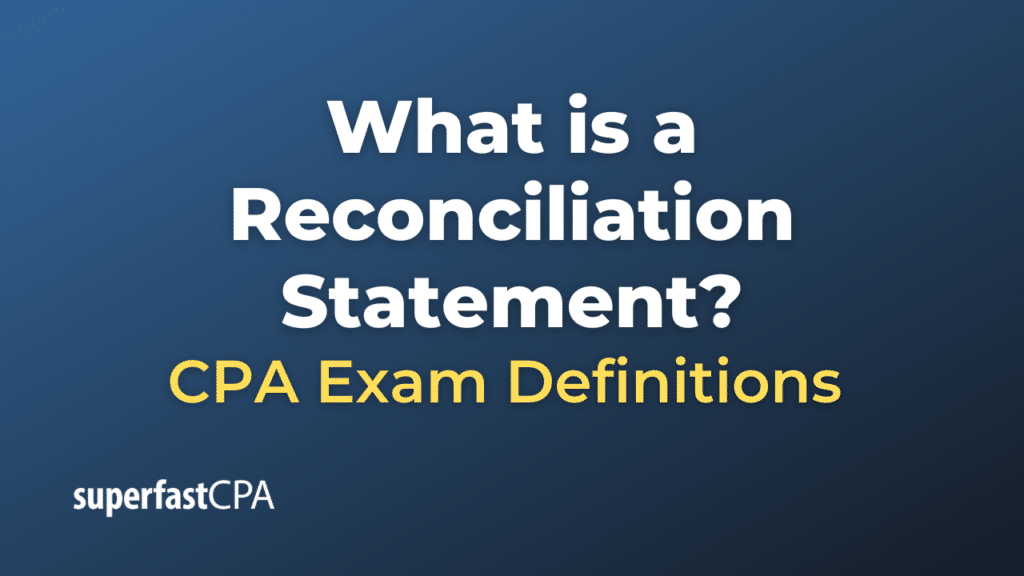Reconciliation Statement
A reconciliation statement, often referred to in the context of bank reconciliations as a “bank reconciliation statement,” is a document that explains the differences between the bank balance shown in an organization’s bank statement, as supplied by the bank, and the corresponding amount shown in the organization’s own accounting records at a particular point in time.
Its main purpose is to:
- Ensure that the records maintained by the organization are consistent and aligned with the bank’s records.
- Identify any discrepancies such as outstanding checks, deposits in transit, bank charges, or errors that cause a difference between the two balances.
Components of a Reconciliation Statement:
- Bank Statement Balance: The ending balance from the bank statement.
- Add:
- Deposits in Transit: Amounts that the organization has recorded as received but which have not yet been credited by the bank.
- Bank Errors Favoring the Company: If the bank made an error in the company’s favor, it will be added to reconcile the balances.
- Deduct:
- Outstanding Checks: Checks the organization has issued that have not been cashed or cleared by the bank.
- Bank Service Charges: Monthly fees or specific service fees charged by the bank.
- NSF (Not Sufficient Funds) Checks: Checks deposited that were returned by the bank due to insufficient funds in the issuer’s account.
- Bank Errors Not Favoring the Company: If the bank made an error not in the company’s favor, it will be deducted to reconcile the balances.
- Adjusted Bank Balance: The result after additions and deductions. This should match the adjusted book balance.
- Book (Ledger) Balance: The ending balance according to the company’s ledger.
- Add or Deduct:
- Interest Income: Interest earned on the bank account.
- Errors made by the Company: If the company recorded a transaction incorrectly, it needs to be adjusted.
- Other Adjustments: Such as electronic funds transfers or automatic payments that the company hasn’t recorded yet.
- Adjusted Book Balance : After making the necessary additions and deductions, the result should equal the adjusted bank balance.
The ultimate goal of the reconciliation statement is to prove that the bank and book balances are, in fact, reconciled, meaning they can be made to agree. If they do not agree after performing the reconciliation, then further investigation will be needed to identify the discrepancies.
Example of a Reconciliation Statement
Let’s go through a simple example of a bank reconciliation statement.
XYZ Company’s ledger shows a bank balance of $5,000 at the end of June. However, the bank statement for June from XYZ’s bank shows an ending balance of $4,750. XYZ Company needs to reconcile its ledger balance with its bank statement balance.
Reconciliation Statement:
- Bank Statement Balance (as per the bank):
- $4,750
- Add:
- Deposits in Transit: XYZ Company deposited $300 on June 30th, but this hasn’t been reflected on the bank statement since it was deposited late in the day.
- Total Additions: $300
- Deduct:
- Outstanding Checks: XYZ Company issued a check of $450 on June 28th which the recipient hasn’t cashed yet.
- Bank Service Charges: The bank statement shows a service fee of $50.
- NSF (Not Sufficient Funds) Check: One of XYZ’s customers gave them a check for $50, which was returned due to insufficient funds.
- Total Deductions: $550
- Adjusted Bank Balance:
- $4,750 (initial balance) + $300 (additions) – $550 (deductions) = $4,500
- Book (Ledger) Balance (as per XYZ Company’s ledger):
- $5,000
- Add:
- Interest Income: The bank statement shows an interest income of $10.
- Total Additions: $10
- Deduct:
- Bank Service Charges: $50 (XYZ hasn’t recorded this yet)
- NSF Check: $50 (needs to be taken out since it was returned)
- Book Errors: Upon reviewing, it was found that a payment of $410 was entered twice in the ledger by mistake.
- Total Deductions: $510
- Adjusted Book Balance:
- $5,000 (initial balance) + $10 (additions) – $510 (deductions) = $4,500
At the end of the reconciliation, the Adjusted Bank Balance ($4,500) matches the Adjusted Book Balance ($4,500), which means the reconciliation is successful and both the bank and book balances are in agreement. If they did not match, XYZ Company would need to further investigate any discrepancies.














